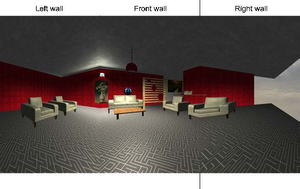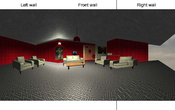Information
- Publication Type: Master Thesis
- Workgroup(s)/Project(s):
- Date: November 2015
- Date (Start): 28. February 2014
- Date (End): 12. November 2015
- TU Wien Library:
- Diploma Examination: 12. November 2015
- First Supervisor:
- Keywords: virtual reality, stereo rendering
Abstract
In this thesis we discuss the use of omnidirectional stereo (omnistereo) rendering of virtual
environments. We present an artefact-free technique to render omnistereo images for
the CAVE in real time using the modern rendering pipeline and GPU-based tessellation.
Depth perception in stereoscopic images is enabled through the horizontal disparities
seen by the left and right eye. Conventional stereoscopic rendering, using off-axis
or toe-in projections, provides correct depth cues in the entire field of view (FOV) for
a single view-direction. Omnistereo panorama images, created from captures of the real
world, provide stereo depth cues in all view direction. This concept has been adopted for
rendering, as several techniques generating omnistereo images based on virtual environments
have been presented. This is especially relevant in the context of surround-screen
displays, as stereo depth can be provided for all view directions in a 360° panorama
simultaneously for upright positioned viewers. Omnistereo rendering also lifts the need
for view-direction tracking, since the projection is independent of the view direction,
unlike stereoscopic projections. However, omnistereo images only provide correct depth
cues in the center of the FOV. Stereo disparity distortion errors occur in the periphery
of the view and worsen with distance from the center of the view. Nevertheless, due
to a number of properties of the human visual system, these errors are not necessarily
noticeable.
We improved the existing object-warp based omnistereo rendering technique for
CAVE display systems by preceding it with screen-space adaptive tessellation methods.
Our improved technique creates images without perceivable artefacts and runs on
the GPU at real-time frame rates. The artefacts produced by the original technique
without tessellation are described by us. Tessellation is used to remedy edge curvature
and texture interpolation artefacts occurring at large polygons, due to the non-linearity
of the omnistereo perspective. The original approach is based on off-axis projections.
We showed that on-axis projections can be used as basis as well, leading to identical
images. In addition, we created a technique to efficiently render omnistereo skyboxes
for the CAVE using a pre-tessellated full-screen mesh. We implemented the techniques
as part of an application for a three-walled CAVE in the VRVis research center and
compared them.
Additional Files and Images
Additional images and videos
Additional files
Weblinks
No further information available.
BibTeX
@mastersthesis{MEINDL-2015-OSR,
title = "Omnidirectional Stereo Rendering of Virtual Environments",
author = "Lukas Meindl",
year = "2015",
abstract = "In this thesis we discuss the use of omnidirectional stereo
(omnistereo) rendering of virtual environments. We present
an artefact-free technique to render omnistereo images for
the CAVE in real time using the modern rendering pipeline
and GPU-based tessellation. Depth perception in stereoscopic
images is enabled through the horizontal disparities seen by
the left and right eye. Conventional stereoscopic rendering,
using off-axis or toe-in projections, provides correct depth
cues in the entire field of view (FOV) for a single
view-direction. Omnistereo panorama images, created from
captures of the real world, provide stereo depth cues in all
view direction. This concept has been adopted for rendering,
as several techniques generating omnistereo images based on
virtual environments have been presented. This is especially
relevant in the context of surround-screen displays, as
stereo depth can be provided for all view directions in a
360° panorama simultaneously for upright positioned
viewers. Omnistereo rendering also lifts the need for
view-direction tracking, since the projection is independent
of the view direction, unlike stereoscopic projections.
However, omnistereo images only provide correct depth cues
in the center of the FOV. Stereo disparity distortion errors
occur in the periphery of the view and worsen with distance
from the center of the view. Nevertheless, due to a number
of properties of the human visual system, these errors are
not necessarily noticeable. We improved the existing
object-warp based omnistereo rendering technique for CAVE
display systems by preceding it with screen-space adaptive
tessellation methods. Our improved technique creates images
without perceivable artefacts and runs on the GPU at
real-time frame rates. The artefacts produced by the
original technique without tessellation are described by us.
Tessellation is used to remedy edge curvature and texture
interpolation artefacts occurring at large polygons, due to
the non-linearity of the omnistereo perspective. The
original approach is based on off-axis projections. We
showed that on-axis projections can be used as basis as
well, leading to identical images. In addition, we created a
technique to efficiently render omnistereo skyboxes for the
CAVE using a pre-tessellated full-screen mesh. We
implemented the techniques as part of an application for a
three-walled CAVE in the VRVis research center and compared
them.",
month = nov,
address = "Favoritenstrasse 9-11/E193-02, A-1040 Vienna, Austria",
school = "Institute of Computer Graphics and Algorithms, Vienna
University of Technology ",
keywords = "virtual reality, stereo rendering",
URL = "https://www.cg.tuwien.ac.at/research/publications/2015/MEINDL-2015-OSR/",
}

 thesis
thesis

